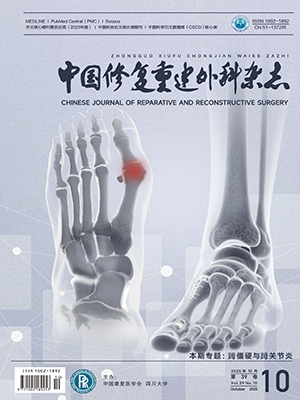| 1. |
Laaksonen T, Kosola J, Nietosvaara N, et al. Epidemiology, treatment, and treatment quality of overriding distal metaphyseal radial fractures in children and adolescents. J Bone Joint Surg (Am), 2022, 104(3): 207-214.
|
| 2. |
孟阁, 马海龙, 管之也, 等. 顺行弹性髓内钉与逆行克氏针治疗儿童桡骨远端干骺交界区骨折的疗效分析. 中国骨与关节杂志, 2023, 12(9): 651-656.
|
| 3. |
McQuinn AG, Jaarsma RL. Risk factors for redisplacement of pediatric distal forearm and distal radius fractures. J Pediatr Orthop, 2012, 32(7): 687-692.
|
| 4. |
Wang R, Wu L, Wang Y, et al. Limited open reduction and transepiphyseal intramedullary kirschner wire fixation for treatment of irreducible distal radius diaphyseal metaphyseal junction fracture in older children. Front Pediatr, 2022, 10: 871044. doi: 10.3389/fped.2022.871044.
|
| 5. |
Sinikumpu JJ, Nietosvaara Y. Treatment of distal forearm fractures in children. Scand J Surg, 2021, 110(2): 276-280.
|
| 6. |
周志林, 刘朝宇, 贾国强, 等. 三种内固定治疗儿童桡骨远端干骺交界区骨折的疗效比较. 中华创伤骨科杂志, 2023, 25(8): 657-662.
|
| 7. |
周志林, 马海龙, 孟阁, 等. 弹性髓内钉摇杆技术治疗儿童桡骨远端干骺交界区骨折. 中国矫形外科杂志, 2023, 31(10): 917-920.
|
| 8. |
Lieber J, Schmid E, Schmittenbecher PP. Unstable diametaphyseal forearm fractures: transepiphyseal intramedullary Kirschner-wire fixation as a treatment option in children. Eur J Pediatr Surg, 2010, 20(6): 395-398.
|
| 9. |
Chaoyu L, Guoqiang J, Wenqiang X, et al. Precision shaping of elastic stable intramedullary nail for the treatment of metaphyseal diaphysis junction fracture of the distal radius in children: a preliminary report in two centers. BMC Musculoskelet Disord, 2023, 24(1): 237. doi: 10.1186/s12891-023-06332-x.
|
| 10. |
Du M, Han J. Antegrade elastic stable intramedullary nail fixation for paediatric distal radius diaphyseal metaphyseal junction fractures: A new operative approach. Injury, 2019, 50(2): 598-601.
|
| 11. |
Cooney WP, Bussey R, Dobyns JH, et al. Difficult wrist fractures. Perilunate fracture-dislocations of the wrist. Clin Orthop Relat Res, 1987, (214): 136-147.
|
| 12. |
孙亮, 刘万林, 韦宜山, 等. 闭合复位顺行弹性髓内钉和克氏针内固定治疗儿童桡骨远端骨干-干骺端交界区骨折的对比研究. 中华小儿外科杂志, 2024, 45(7): 631-637.
|
| 13. |
刘朝宇, 徐文强, 贾国强, 等. 弹性髓内钉精准塑形治疗儿童桡骨远端骨干-干骺端交界区骨折. 中华小儿外科杂志, 2023, 44(7): 631-635.
|
| 14. |
Li J, Rai S, Tang X, et al. Fixation of delayed distal radial fracture involving metaphyseal diaphyseal junction in adolescents: a comparative study of crossed Kirschner-wiring and non-bridging external fixator. BMC Musculoskelet Disord, 2020, 21(1): 365. doi: 10.1186/s12891-020-03404-0.
|
| 15. |
Parikh SN, Jain VV, Youngquist J. Intrafocal pinning for distal radius metaphyseal fractures in children. Orthopedics, 2013, 36(6): 783-788.
|
| 16. |
Cai H, Wang Z, Cai H. Prebending of a titanium elastic intramedullary nail in the treatment of distal radius fractures in children. Int Surg, 2014, 99(3): 269-275.
|




